Dell Latitude 7030 Rugged Extreme Tablet
Dell's fully-rugged tablet gets a full re-design and major technology update
(by Conrad H. Blickenstorfer)
On October 12, 2023, Dell introduced the Lattitude 7030 Rugged Extreme Tablet not in a press release, but in its blog. The new 7030 is a rugged 10-inch Windows tablet, which means that Dell is now represented in the rather competitive (vertical) market for heavy duty small & light tablet computers for the field. Judging by the specs, the newcomer should pack just as much punch as Dell's quite formidable 12-inch Latitude 7230 Rugged Extreme.
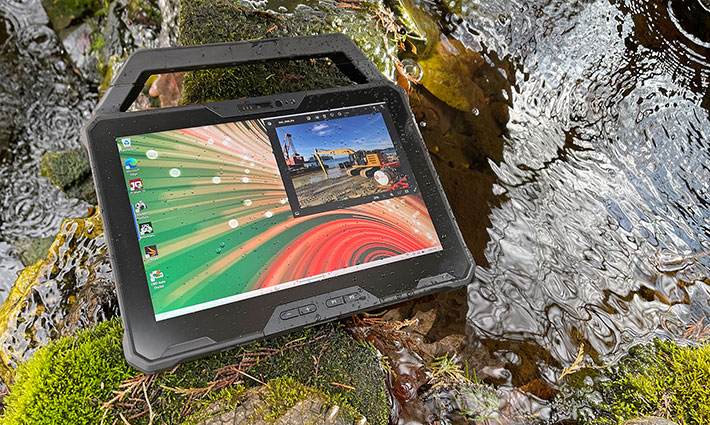
Apart from now having an entry in the 10-inch market, Dell sees the new 7030 as a companion product to its larger 12-inch 7230 (see our full review). But if Dell sees them as companions, can the small tablet measure up when handling workloads? It can, because it uses almost identical tech with the exact same Intel 12th gen processor options and the same 1920 x 1200 pixel resolution.
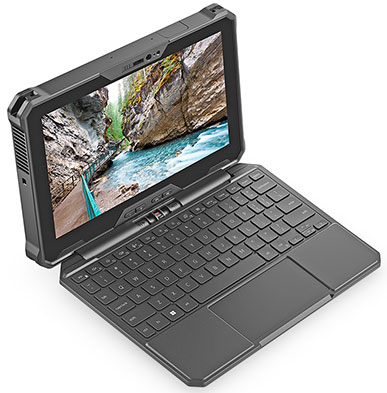 The new 10-inch 7030 is considerably smaller and lighter than the 12-inch 7230, and that can make a big difference. The 7030's starting weight is 2.24 pounds, whereas the bigger tablet weighs in starting at 2.82 pounds.
The new 10-inch 7030 is considerably smaller and lighter than the 12-inch 7230, and that can make a big difference. The 7030's starting weight is 2.24 pounds, whereas the bigger tablet weighs in starting at 2.82 pounds.
The 12-inch tablet, of course, has 41% more screen real estate than the 7030, and also an extra USB port. So, it'd be fair to say that the 12-inch tablet is geared more towards mostly stationary applications, whereas the smaller, lighter 10-inch tablet is perfect for jobs where it may be carried around all day long.
When it comes to computing on the go, one screen size doesn't fit all. Even small differences can make one size and design feel just right while another one just isn't. Just look at smartphones. They grew and grew in size until they were large enough to reasonably handle everything we use phones for these days, but not so large as to become unwieldy and uncomfortable. But they still come in different screen sizes.
With tablets is the same. What's just perfect for some is too large or too small for others. And some tasks are simply better done on this size or that size. That's why it's good to offer Windows tablets in both leading sizes, those with 10 inch and those with 12 inch screens.
Adding the 10-inch 7030 to its rugged lineup puts Dell in a good position. Most of the competition in the rugged Windows tablet segment offers both sizes, and now Dell is represented in both size classes as well.
Personal preferences, however, aren't all that matters. A device also must be able to get the job done, and done well. Which means that knowing what a device can and cannot do is important. The table below shows how the Dell Latitude 7030 and 7230 Rugged Extreme Tablets stack up against each other:
|
Dell Latitude
|
7030 Rugged Extreme
|
7230 Rugged Extreme
|
|
|
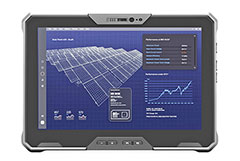
|
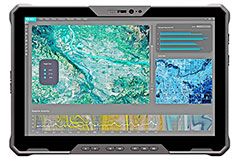
|
|
Launched
|
October 2023
|
October 2022
|
|
Intel Core CPU generation
|
Intel 12th gen Core
|
Intel 12th gen Core
|
|
Available CPU options
|
i3-1210U, i5-1240U, i7-1260U
|
i3-1210U, i5-1240U, i7-1260U
|
|
Display
|
10.1" 1920x1080 (224 ppi)
|
12.0" 1920x1200 (189 ppi)
|
|
Aspect ratio
|
16 : 10
|
16 : 10
|
|
Luminance
|
1000 nits (1195 as tested)
|
1200 nits (1337 as tested)
|
|
Size
|
10.3 x 7.4 x 1.00 inches
|
11.7 x 8.0 x 0.94 inches
|
|
Weight
|
from 2.24 lbs.
|
from 2.80 lbs.
|
|
RAM
|
up to 32GB LPDDR5
|
up to 32GB LPDDR5
|
|
Mass storage
|
up to 2TB PCIe NVMe
|
up to 2TB PCIe NVMe
|
|
Wi-Fi
|
Wi-Fi 6E
|
Wi-Fi 6E
|
|
Power
|
36 whr or 2 x 18 whr Li-Ion
|
1 or 2 x 35.6 whr
|
|
Battery Life
|
PCMark 10 battery test: 8:16 hrs (36.0 whr)
|
PCMark10 battery test: 11:51 hrs (71.2 whr)
|
|
Cameras
|
opt. 5 and 11mp
|
opt. 5 and 11mp
|
|
USB Type A
|
1 x USB 3.2
|
2 x USB 3.2
|
|
USB Type C
|
2 x Thunderbolt 4 or 2 x USB 4
|
2 x Thunderbolt 4
|
|
Expansion
|
RJ45, USB-A, scan
|
RJ45, HDMI, scan, COM, Fischer
|
|
Handle
|
Opt. soft or rigid
|
Opt. soft or rigid
|
|
Kickstand
|
fixed angle
|
fixed angle
|
|
Programmable buttons
|
2
|
3
|
|
Sealing
|
IP65
|
IP65
|
|
Transit Drop
|
4-feet
|
4-feet
|
As you can see, the two are very close indeed. Their technology specs are pretty much identical, as are their ruggedness, ports and connectivity specs. The 7030 weighs a good half pound less, its screen is not quite as bright (though the visual difference between 1000 and 1200 nits isn't much), and for some reason the 7030 is available with two different battery configurations — either an internal 36 whr battery or two externally and thus hot-swappable 18 watt-hour batteries.

One thing that's immediately impressive is how easy Dell made it to use the 7030 as either a tablet or as a laptop computer. That's important, because 2-in-1 devices represent a growing segment in the tablet market, and how, exactly it's done can make a huge difference in real-world usability (and thus sales).
Two-in-one design solutions have been around almost as long as Windows tablets. There are "connected" solutions where the tablet and the screen are one unit, but the display can be repositioned so that the device can be used as either a laptop or a tablet. The advantage of that approach is that you won't ever forget to take the keyboard along as it's part of the system. The disadvantage of connected designs is that they are heavy.
Dell used to have a connected rugged 2-in-1, the original Latitude 12 Rugged Extreme (see our 2015 review here). Dell's solution for the new 7030 (and 7230) is different; the tablet and the (optional) keyboard are separate, but can be joined together to make a fully functional laptop. That's as compared to wireless or USB keyboards, where the keyboard always feels a bit like an afterthought and you have to somehow prop up the tablet. The pictures below shows how Dell's approach works:
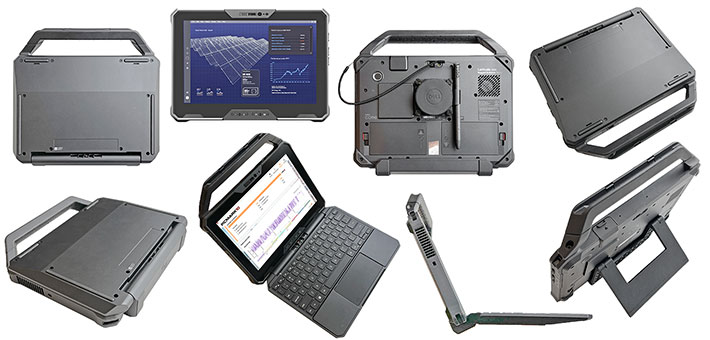
The keyboard is designed just for the 7030 tablet, which snaps into the hinged keyboard so that the combination works like a laptop in every way. Unlike some such solutions, the Dell keyboard isn't a port replicator. It's just a keyboard, albeit a very solid, very high-quality one (it alone weighs 1.8 pounds) that even has keyboard backlighting. Used in conjunction with the optional carry handle, you can easily take the 7030 everywhere. It works just like a laptop when needed, or it can be removed from the keyboard and used as a light and handy tablet.
There are a couple of issues you need to be aware of. One is inherent in pretty much all 2-in-1s — since the tablet part includes not only the screen and electronics but also the battery, the the tablet/keyboard combination is top-heavy and can only be tilted backward so much before it tips over. The other is that the ever-important QWERTY part of the keyboard layout is only 92.5% scale. That matters to touch typists and also to advanced hunt & peckers whose muscle memory expects the distance between the centers of the Q key on the left and the P key on the right to be exactly 6.75 inches. I wish Dell would have made the QWERTY layout full-scale by just making the function keys to the left and right a bit narrower.
At the bottom right, note another option, Dell's simple tablet stand, is an inexpensive solution for those who just want a stand, or who want to use the 7030 with a wireless or USB keyboard. The angle of the stand can be adjusted in three positions
The 7030 and Dell's rugged products design, look, and feel
All of Dell's Rugged and Rugged Extreme laptops and tablets are part of the company's Latitude line of business laptops and can be viewed at the Latitude Rugged laptops and tablets section. Going to dell.com/rugged gets you to the same place. To shop for Dell rugged models, go here. It's a bit confusing, all those locations, and we wish Dell would be clearer as to where the rugged lineup is and what part of the company it belongs to.
Even though all of Dell's rugged laptops and tablets are part of the "Latitude" line, that doesn't mean they are simply heavier-duty and better protected versions of standard Dell Latitude products. Instead, while the rugged products may share certain components and technologies from models in the Latitude lineup, they are unique and separate designs from the ground up. While "civilian" business Latitudes sport a sleek, elegant contemporary consumer/business laptop look, the rugged models use a different, tougher looking design language.
As is, Dell has done an excellent job in visually differentiating their rugged offerings from more civilian and enterprise platforms, all the while creating a sharp, purposeful and quite elegant design. It's a style that's not as overtly utilitarian as some competing rugged computing gear; Dell went more for an elegant, high quality look. The tablet feels tough, solid and substantial, and there's never a doubt that this is a much heavier-duty computing device than any standard consumer or even business tablet.
But let's take a closer look at the Dell Latitude 7030 Rugged Extreme Tablet. Below you can see the top and all four sides of the machine:
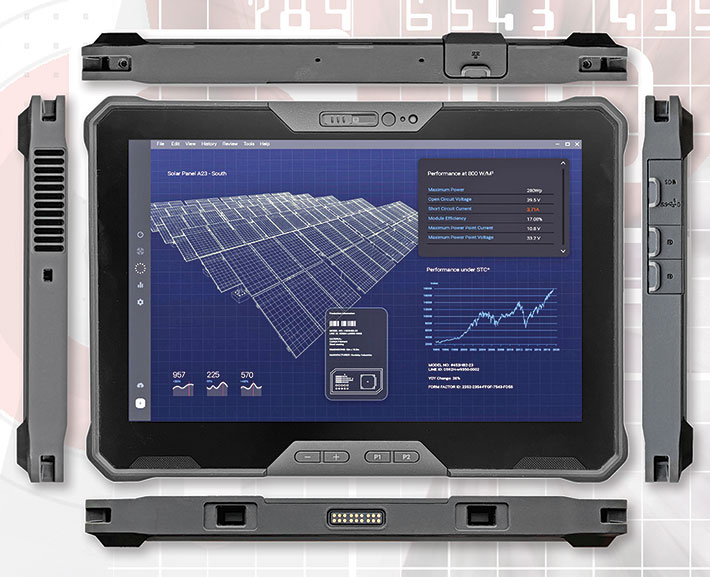
Dell's using just one color here, black. The housing is black reinforced polycarbonate plastic, with the front bezel and sides having a matte, rubberized finish. There are protective corner bumpers that are nicely integrated into the overall design. Since the tablet has a capacitive touch screen, the front glass extends flush well beyond the actual LCD perimeter, just as it should for comfortable touch operation. And the actual housing bezel surrounding the glass slightly angles up, so as to provide extra protection to the screen without having your fingers bump into it. The glass surface itself is glossy but in a matte, muted way.
Below the display, which is clearly designed to be used in landscape orientation, are four physical buttons labeled +, -, P1 and P2. The +/- buttons can be set for volume or brightness up or down, or both combined via short or long presses. The P1 and P2 buttons can be assigned to do just about anything, including macros. All labels are very legible. The front camera, with its manual privacy shutter, is in the center where it belongs, and it has a manual shutter.
Ports and connectivity are both on the right and top side of the tablet. To guard against physical damage, all ports are located behind protective doors that snap into place. The picture below shows, on top, the right side of the unit with all protective doors removed for a better view at the ports. From left to right there are two Type-C USB4 ports with power delivery and DisplayPort capability, then a Type-A USB 3.2 Gen port with PowerShare with a Micro SD card slot beneath it. The I/O area on top had an RJ45 LAN jack in our test unit, but can also have a barcode scanner, another USB Type-A port, or a standard audio jack.

The left side of the 7030 has the fan exhaust grill and a Kensington type physical lock slot.
Overall, just like the larger 7230, the design of the Dell Latitude 7030 Rugged Extreme Tablet is very well done, merging ruggedness and functionality into a tool for the job. It is a practical solution that looks and feels just right.
Capacitive multi-touch — works with gloves
The Dell Latitude 7030 Rugged Extreme Tablet, like virtually every other modern tablet, offers 10-point capacitive multi-touch. Tapping, panning, swiping, pinching and zooming work smoothly and effortlessly with none of the slight delay that used to bedevil touch on Windows hardware.
The capacitive touch screen of the Rugged Tablet also handles gloves quite well. The tablet display surface is as smooth as we've come to expect from capacitive touch technology.
 The tablet comes with a 4-inch capacitive stylus. Dell has been experimenting with different types of styli over the years. The old 7212 tablet had a narrow 3mm hard rubber tip, the 7220 a hard 6mm tip, and, now, the one for the 7030 and 7230 has a slightly narrower hard 5mm tip. The stylus provides a pencil-like sensation and even sound, but we had to get used to a stylus with such a thick tip. When not in use, the stylus, which has an almost foot-long spiral tether cord, can be parked in a special garage on top of the tablet.
The tablet comes with a 4-inch capacitive stylus. Dell has been experimenting with different types of styli over the years. The old 7212 tablet had a narrow 3mm hard rubber tip, the 7220 a hard 6mm tip, and, now, the one for the 7030 and 7230 has a slightly narrower hard 5mm tip. The stylus provides a pencil-like sensation and even sound, but we had to get used to a stylus with such a thick tip. When not in use, the stylus, which has an almost foot-long spiral tether cord, can be parked in a special garage on top of the tablet.
Note that Dell offers an active pen option, though we're not sure what active technology Dell is using with it. The tablet's capacitive multi-touch was fast and precise enough for most tablet operations, though we also often used the stylus.

Intel 12th gen "Alder Lake" power
Like its somewhat larger 12-inch 7230 sibling, the Latitude 7030 Rugged Extreme Tablet is powered by Intel "Alder Lake" 12th generation Core processors.
When it initially appeared, Alder Lake was more than just a new Intel chip generation. It was Intel's first major "hybrid" processor design, combining complex, powerful performance cores ("p-cores") and smaller, simpler economy cores ("e-cores"). Why using two types? Because it's not power-efficient to use hot-running high-performance cores for simple routine or background work. Smartphones, both on the iPhone and the Android side, have been using different cores for different work for years.
So what "Alder Lake" chips bring is combinations of p-cores and e-cores. On the p-core side Intel is using a new high-end microarchitecture called Golden Cove. 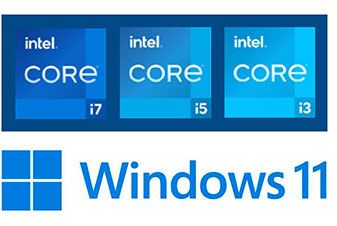 On the e-core side, which is basically Intel Atom processor technology, there's also a new microarchitecture named Gracemont. According to Intel, each Gracemont economy core is capable of as much or more performance than one of Intel's 6th generation "Skylake" cores of not so long ago (a remarkable accomplishment), at much lower power consumption.
On the e-core side, which is basically Intel Atom processor technology, there's also a new microarchitecture named Gracemont. According to Intel, each Gracemont economy core is capable of as much or more performance than one of Intel's 6th generation "Skylake" cores of not so long ago (a remarkable accomplishment), at much lower power consumption.
How does this mix of p-cores and e-cores work? The idea is to route heavy-duty, time-critical work to the p-cores and simpler tasks of lesser importance to e-cores. To do that, Intel and Microsoft worked together on "Thread Director," a technology that examines work and decides what goes to which type of core. Only Windows 11 includes full thread director capabilities; Alder Lake runs Windows 10, but without taking full advantage of the new chips.
The table below shows the three processors available for the Dell Latitude 7030 Rugged Extreme Tablet, with their major specs (see the full table here):
|
|
CPU Options
|
Intel
|
Intel
|
Intel
|
|
|
Intel
|
Core i7-1260U
|
Core i5-1240U
|
Core i3-1210U
|
|
|
Codename
|
Alder Lake
|
Alder Lake
|
Alder Lake
|
|
|
Performance Cores
|
2 cores/4 threads
|
2 cores/4 threads
|
2 cores
|
|
|
Efficiency Cores
|
8
|
8
|
4
|
|
|
Total threads
|
12
|
12
|
10
|
|
|
Max Turbo Speed
|
3.50/4.70 GHz
|
3.30/4.40 GHz
|
3.30/4.40 GHz
|
|
|
Thermal Design Power (TDP)
|
9/29 watts
|
9/29 watts
|
9/29 watts
|
|
|
Smart Cache
|
12MB
|
12MB
|
4MB
|
|
|
Integrated graphics
|
Intel Iris Xe
|
Intel Iris Xe
|
Intel UHD Graphics
|
|
|
Graphics max speed
|
900 MHz
|
900 MHz
|
850 MHz
|
|
|
Graphics EUs
|
96
|
80
|
64
|
|
|
Intel vPro
|
Yes
|
Yes
|
No
|
|
|
Intel SIPP
|
Yes
|
Yes
|
No
|
|
|
Intel Trusted Execution
|
Yes
|
Yes
|
No
|
These are the exact same chips as Dell offers in the 12-inch 7230 tablet — one each of the i3 ("good"), i5 ("better") and i7 ("best") versions of Intel's 12th generation "Alder Lake" processors. At first sight, there seems to be less performance difference between available processors than we've seen in the past. All three CPU options have two performance cores, all are 9/29 watt designs, and even the i3 chip now comes with turbo boost.
At the low end is the Core i3-1210U with two performance cores, each having two threads, and four efficiency cores. That makes for a total of eight processing threads. The efficiency and performance cores max out at 3.30 and 4.40 GHz, respectively, there's 10MB of Intel Smart Cache, there's no vPro, and the i3-1210U only supports Intel UHD Graphics on 64 execution units.
Available for about $150 more is the mid-range Core i3-1240U with two performance cores, each with two threads, and eight efficiency cores. That makes for a total of 12 processing threads. The efficiency and performance cores max out at 3.30 and 4.40 GHz, respectively, just like the i3 chip, but there's 12MB of Intel Smart Cache, vPro support, and the i5-1240U supports the more powerful Intel Iris Xe Graphics on 80 execution units.
For another $190 you get the top-of-the-line Core i7-1260U, also with two performance cores, eight efficiency cores, 12 processing threads, 12MB of Intel Smart Cache and vPro support. Here, the efficiency and performance cores max out at slightly higher 3.50 and 4.70 GHz, respectively, but the i7-1260U runs Intel Iris Xe Graphics on 96 execution units.
How well does the Dell Latitude 7030 perform with this for Intel still new hybrid processor architecture? That question is addressed in the benchmark table below, where we are comparing the performance of the 7030 to Dell's 10-inch class tablet competition from other industry leaders, and also show the data for Dell's larger 12-inch 7230 tablet.
|
Dell Latitude 7030 Rugged Extreme Tablet vs 10-inch class rugged tablets
|
|
Company
|
Dell
|
Dell
|
DT Research
|
Getac
|
Handheld
|
Mobile Demand
|
|
Model
|
7030
|
7230
|
DT301Y
|
UX10
|
10XR
|
T1175
|
|
Year tested
|
2024
|
2023
|
2024
|
2021
|
2023
|
2024
|
|
CPU Type
|
Intel Core
|
Intel Core
|
Intel Core
|
Intel Core
|
Intel Atom
|
Intel Core
|
|
CPU model
|
i7-1260U
|
i5-1240U
|
i7-1165G7
|
i7-10510U
|
x6413E
|
i5-1335U
|
|
Display size
|
10.0-inch
|
12.0-inch
|
10.1-inch
|
10.1-inch
|
10.1-inch
|
10.1-inch
|
|
Resolution (pixels)
|
1920 x 1200
|
1920 x 1080
|
1920 x 1200
|
1920 x 1200
|
1920 x 1200
|
1920 x 1200
|
|
Luminance
|
1,195 nits
|
1,337 nits
|
890 nits
|
1004 nits
|
930 nits
|
688 nits
|
|
Footprint (inches)
|
10.36 x 7.40
|
11.65 x 8.00
|
11.00 x 7.80
|
10.8 x 7.5
|
11.1 x 7.1
|
11.54 x 7.56
|
|
Thickness (inches)
|
1.00
|
0.94
|
0.86
|
0.88
|
1.0
|
0.67
|
|
Volume (cu-in)
|
76.7
|
87.6
|
71.0
|
71.3
|
78.8
|
58.5
|
|
Weight as tested (lbs.)
|
2.24
|
2.76
|
3.10
|
2.68
|
2.70
|
2.73
|
|
Operating temp
|
-20° to 145° F
|
-20° to 145° F
|
14° to 140° F
|
-20° to 145° F
|
-4° to 140° F
|
-14° to 122° F
|
|
Ingress Protection rating
|
IP65
|
IP65
|
IP65
|
IP65
|
IP65
|
IP65
|
|
PassMark 6.1
|
7,624
|
8,364
|
5,843
|
6,627
|
2,636
|
8,240
|
|
PassMark 9.0
|
5,607
|
5,516
|
4,787
|
3,869
|
1,917
|
5,067
|
|
CrystalMark
|
465,144
|
401,322
|
448,119
|
315,866
|
210,757
|
465,528
|
|
PCMark 10 Overall
|
5,052
|
4,847
|
4,680
|
3,869
|
2,344
|
4,801
|
|
PCMark 10 Disk
|
2,184
|
2,015
|
2,405
|
1,949
|
665
|
1,838
|
|
PCMark 10 Battery
|
8:16 hrs
|
11:51 hrs
|
9:31 hrs
|
NA
|
3:37 hrs
|
6:01 hrs
|
|
3DMark TimeSpy
|
1,383
|
1,142
|
1,121
|
414
|
208
|
1,237
|
|
GeekBench 5 single core
|
1,562
|
1,496
|
1,453
|
1,123
|
661
|
1,565
|
|
GeekBench 5 multi core
|
7,001
|
7,049
|
3,843
|
2,839
|
1,899
|
4,810
|
|
GeekBench 5 Open CL
|
13,525
|
10,713
|
11,150
|
NA
|
2,104
|
12,377
|
As always, the results in the above table should not be construed as an absolute comparison of which product is fastest. Each of the listed devices comes/came with several processor options, and products may have been upgraded since we last benchmarked them in the RuggedPCReview.com testing lab. So view the numbers as what sort of performance can be expected from different types of processors and processor generations, clock speeds, and thermal design powers.
What is immediately clear is that the Dell 7030 Latitude Rugged Extreme Tablet is a serious performer that's as fast or faster than its current Tier 1 10-inch rugged tablet competition. Dell packed an awful lot of punch into this tough and handy little machine! It's even faster than the 12-inch 7230 we tested last year, though that was to be expected given that our 7030 test unit had the top available chip and the 7230 came with the mid-range option.
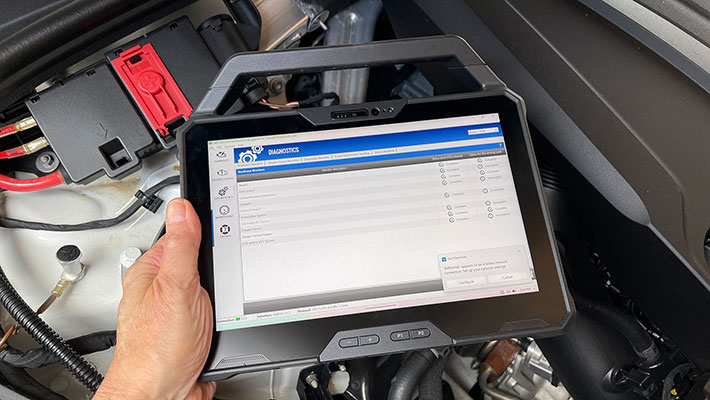
I should mention that benchmark performance of the 7030 is significantly higher when plugged in than it is when run on battery power. Depending on the benchmark, AC/DC performance can be 40-50% higher than battery performance. Intel's DTT (Dynamic Tuning Technology) gives manufacturers the option to configure their products with different running modes. Dell appears to have configured the 7030 for maximum performance when plugged in, and maximum operation time when running on battery. We noticed that same tuning approach when we tested the 7230 last year.
Battery life
While the small 10-inch Latitude 7030 performs at the same high level as the larger 12-inch Latitude 7230, it has to do so with substantially less onboard battery power. We're talking two small 18 watt-hour batteries in the 7030 versus two much larger 36 watt-hour batteries in the 7230. That means the smaller tablet only has half the battery power. That's not much.
 Why did Dell give the 7030 so little battery? Probably because customers who buy a small 10-inch tablet want for it to be as small and light and handy as possible. Which the 7030 is. Ours weighed just 2.24 pounds with two batteries. But will it run long on a charge to meet expectations on the job?
Why did Dell give the 7030 so little battery? Probably because customers who buy a small 10-inch tablet want for it to be as small and light and handy as possible. Which the 7030 is. Ours weighed just 2.24 pounds with two batteries. But will it run long on a charge to meet expectations on the job?
Early laptops and tablets often ran just an hour or two until the battery conked out. Those days are long gone. The original 10-inch iPad forever changed tablet battery life expectations to eight hours or more. That gets you through a whole day, or a full 8-hour work shift with the computer on and used the entire time. Anything less means recharging — which is quite an interruption for devices with internal batteries — and less so with tablets that have exchangeable batteries. Still having to carry around charged spares can be a pain as well.
As is, Dell offers the 7030 with either an internal, non user-accessible battery, or with two external batteries. The total battery capacity is the same, a total of 36 watt-hours. We're not sure what the rationale behind this is. Our review machine came with the two pop-in batteries, which would be our preference anyway. Dell claims up to 8 hours for either version. To find out we tested power draw with PassMark's BatMon utility and then also ran UL Systems' PCMark Battery test.
|
Dell Latitude 7030 Rugged Extreme Power Draws (at idle)
|
|
Backlight level
|
Lowest (0%)
|
50%
|
Maximum (100%)
|
|
Power Saver
|
3.6 watts (10.0 hrs)
|
4.3 watts (8.4 hrs)
|
8.4 watts (4.3 hrs)
|
|
Max Performance
|
3.8 watts (9.5 hrs)
|
4.7 watts (7.7 hrs)
|
8.8 watts (4.1 hrs)
|
With Windows set to "Power Saver" and screen brightness at its dimmest (which is very dim), we saw a power draw as low as 3.6 watts, good for a theoretical 10.0 hours. With the backlight at 50%, we saw 4.3 watts, good for a theoretical 8.4 hours. And with the backlight all the way up, power draw rose considerably to 8.4 watts, good for a theoretical 4.3 hours.
With Windows set to "Max Performance" and screen brightness at its dimmest, we saw a power draw as low as 3.8 watts, good for a theoretical 9.5 hours. With the backlight at 50%, we saw 4.7 watts, good for a theoretical 7.7 hours. And with the backlight all the way up, power draw rose to 8.8 watts, bringing theoretical battery life down to an unremarkable 4.1 hours.
 Two observations here. First, these draws are remarkably similar to those of the 7230 with its bigger and even brighter 12-inch screen. We'd expect the smaller screen with its slighter lower maximum luminance to draw less power. Second, power draw, which we measured every three seconds fluctuated a lot, so we don't have much confidence in the recorded values. And finally, all the BatMon utility does is measure power draw with the computer on but just idling, with no user apps running.
Two observations here. First, these draws are remarkably similar to those of the 7230 with its bigger and even brighter 12-inch screen. We'd expect the smaller screen with its slighter lower maximum luminance to draw less power. Second, power draw, which we measured every three seconds fluctuated a lot, so we don't have much confidence in the recorded values. And finally, all the BatMon utility does is measure power draw with the computer on but just idling, with no user apps running.
The PCMark 10 battery test is an entirely different story. You calibrate the screen to about 200 nits luminance (so that results are comparable between all the machines we test), and then the battery benchmark continually runs all sorts of typical user tasks until the battery is empty and the system shuts down. The bigger 7230 lasted 11 hours and 51 minutes in this test, with two batteries packing a total of 71.2 watt-hours. Would the smaller 7030 with just half the battery power get barely more than half that?
No, there was a pleasant surprise. The 7030 ran a full 8 hours and 16 minutes in the PCMark 10 battery test. More than a full shift of continuous use, and more than Dell specified. That's quite impressive.
A look inside
Inside, rugged Windows tablets are very different from iPads or Android devices. Whereas the latters' interior is taken up mostly by a big, flat battery and a tiny hyper-integrated circuitboard, Windows tablets still look like laptops inside. That is because there is a full PC squeezed into a compact box, something Dell has great experience in. Parts are becoming more and more miniaturized and integrated, but inside a modern tablet like the Latitude 7030 Rugged Extreme it still looks like a PC with all sorts of wires, connectors, components and modules.
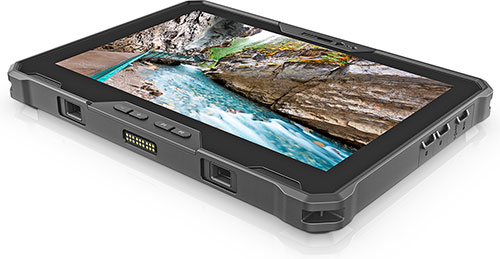 The challenge for designers and manufacturers of rugged Windows tablets is creating a very compact package that not only accommodates a whole PC with all requisite connectivity, but also one that's sealed against dust and liquids, and can handle drops and vibration.
The challenge for designers and manufacturers of rugged Windows tablets is creating a very compact package that not only accommodates a whole PC with all requisite connectivity, but also one that's sealed against dust and liquids, and can handle drops and vibration.
Given Dell's status as one of the world's PC makers — they are third behind only Lenovo and HP — you'd think they'd simply start with one of their consumer or enterprise designs and reconfigure that for a smaller, tougher, better sealed tablet housing. But laptops are laptops and tablets tablets, and besides that, Dell doesn't make any small 10-inch laptops.
But how about just shrinking the existing 12-inch Latitude 7230 Rugged Extreme Tablet? That's more like it, and that's what Dell did when they created the 7030. Comparing the inside of the 7030 to that of the larger 7230, we found the same layout and a lot of the same components.
Unlike most Windows laptops and many tablets, the Latitude 7030 Rugged Extreme Tablet doesn't have multiple removable covers on its back to provide access to RAM memory and internal expansion slots. So if you want to add or replace anything inside or if maintenance becomes necessary, you have to open up the tablet. Even then, RAM is soldered on, and there isn't an easy way to replace storage.
Opening, though, is easy (if you have a Torx 8 screwdriver bit). Undo 16 small Philips screws and the halves come apart. There are two ribbon cables between the halves, one for battery and the other for the fingerprint reader in the back of the tablet.

The seal between the back and the front part of the housing — both made of impact-resistant, flame-retardant, glass fiber-reinforced PC-GF20FR(40) polycarbonate — is a hard plastic lip on the backside that presses onto a thin black (in designs like that, we like to see the seal in a contrasting color; that makes it much easier to examine it for damage) rubber o-ring seal sitting in a channel on the front side. The o-ring seal is long and complex but seems replaceable. What's interesting here is that the seal doesn't just go along the perimeter of the tablet. Instead, it weaves in and out, protecting the electronics inside, but leaving anything I/O-related outside.
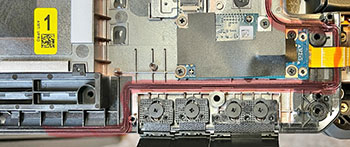 The reason for this is that it is not easy to properly seal rugged tablet ports and connectors. In many rugged devices those ports are not actually sealed well to the inside. Instead, rubber plugs and hinged doors provide the sole protection. If one of them isn't closed properly, liquids can enter the inside of such devices. With Dell's design, it can't. Note the red highlight in the image to the right. That's the seal that keeps liquids outside even if a port should fail or forgotten to be closed.
The reason for this is that it is not easy to properly seal rugged tablet ports and connectors. In many rugged devices those ports are not actually sealed well to the inside. Instead, rubber plugs and hinged doors provide the sole protection. If one of them isn't closed properly, liquids can enter the inside of such devices. With Dell's design, it can't. Note the red highlight in the image to the right. That's the seal that keeps liquids outside even if a port should fail or forgotten to be closed.
Given how likely it is that a port cover isn't properly in place or hasn't been properly closed, doing it Dell's way is more complex, but potential damage would be limited to a replaceable I/O module and not the entire tablet. And I say "potential" damage, because Dell actually applies what they call HZO liquid protection and describe as a "nanotechnology solution that inoculates electronic components from damage and failure." An additional advantage of separating I/O modules from the motherboard is that this makes it much easier to upgrade and/or customize I/O. No need to redesign the motherboard.
The internal layout of the Latitude 7030 Rugged Extreme Tablet is quite complex and components such as WiFi (ours had an Intel Wi-Fi 6E AX211 802.11ax with MIMO + Bluetooth 5.2 card) and PCIe NVMe SSD mass storage aren't as easily accessible as in the larger 7230. The socket for optional wireless modules as well as the various antenna blocks, though, are all in plain sight once the tablet is opened.
Overall, component modularity is in Dell's DNA as the result of decades of offering a vast number of permutations of options available right on Dell's website. So almost any feature for which there might be alternatives — or of which a customer might want more or less of — is not on the motherboard but designed as modules.
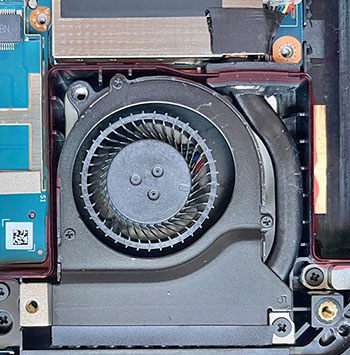 One thing that's immediately obvious is the Latitude 7030 Rugged Extreme Tablet's thermal management. That includes a small fan with a plastic enclosure that, of course, is sealed towards the interior of the device (see red highlight). A black-coated copper pipe conducts heat away from the processor, ancillary electronics, and also the PCIe-based SSD.
One thing that's immediately obvious is the Latitude 7030 Rugged Extreme Tablet's thermal management. That includes a small fan with a plastic enclosure that, of course, is sealed towards the interior of the device (see red highlight). A black-coated copper pipe conducts heat away from the processor, ancillary electronics, and also the PCIe-based SSD.
Interestingly, the original Dell Rugged Tablet of 2015 only had a tiny and nearly invisible fan and no heat pipes. Why the change to beefier thermal management? That's because the original tablet's relatively low-performance processor had a Thermal Design Power (a measure of CPU performance) rating of just 4.5 watt whereas the one in this tablet is high-power, high-performance design that can go up to as high as 55 watts.
But isn't the processor trio available for the 7030 still considered "ultra-low voltage" by Intel? And aren't all ultra-low voltage processors supposed to be able to operate without potentially noisy and troublesome fans in Windows tablets?
Only under certain circumstances. That's because years ago Intel's ultra-low voltage processor did not have a "turbo" mode that allows CPUs to briefly run much faster than their nominal clock frequency, as long as temperatures don't exceed certain levels.
As in cars, "turbo" is a great thing, but it does require proper cooling and management. When a rugged tablet gets too hot out there on the job and there is no active cooling, performance will drop, sometimes to unacceptable levels. That's why Dell chose to go with a fan in the Latitude 7030 Rugged Extreme Tablet. This way, performance will not drop due to overheating.
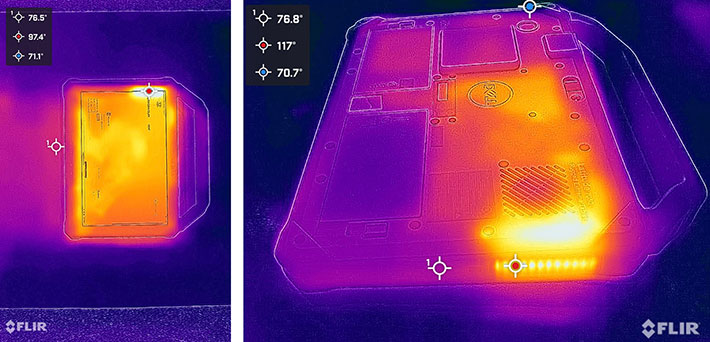
The pictures above show the Dell Rugged Extreme Tablet's thermal engineering, taken with our FLIR One Pro infrared camera during a strenuous PCMark 10 performance test benchmark run.
The bright yellow areas are the hottest, and that is where the heat is conducted away from electronics via the system's thermal pipes. On the left you can see the 7030's front with the hottest spot just about human body temperature. On the right a look at fan/heat exchanger are on the backside of the tablet. Here we're seeing a max of 117F, very acceptable, and actually cooler than what we sa in the 12-inch 7230 that at times reached high spots of almost 140F.
Bottomline of this inside checkup of the Dell Latitude 7030 Rugged Extreme Tablet is that it is a complex, sophisticated design that nicely highlights Dell's great experience in mobile computing technology. Components and modules are clearly marked and have their own 2D scan code. Wires that go from modules to their respective antennae located around the perimeter of the tablet for best reception are guided and held in place with little loops and guides. The what seems magnesium frame adds to the overall ruggedness and rigidity without making the tablet too heavy or look like a tank.
Excellent display
The Latitude 7030 Rugged Extreme Tablet has a display that measures 10.0 inches diagonally. It offers 1920 x 1200 pixel resolution, which makes for a 16:10 wide format aspect ratio and 224 ppi (pixels per inch). Compared to the larger 7230 tablet with its 12-inch screen, the 7030 has 30.6% less screen real estate, but since the resolution is the same, the 7030 screen has 20% more pixels per inch, making it sharper. The same number of pixels means you see the same amount of data on the display, just smaller.
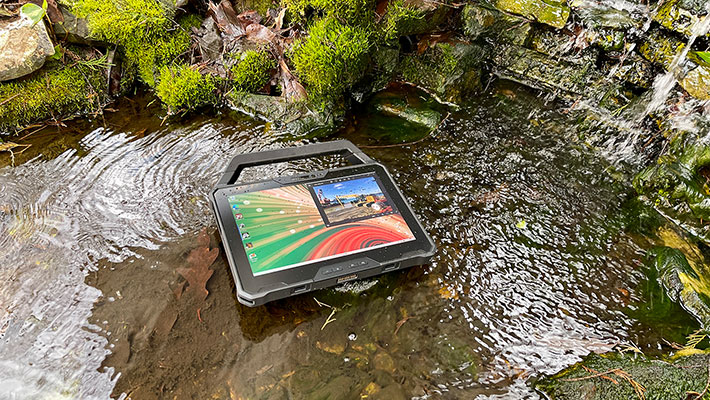
But, regardless of size or sharpness, providing the right display for a system that's being used outdoors is much more difficult than for one that's mostly used indoors in an office or at home. That's because we now have incredibly sharp, photorealistic-grade displays for indoor use, displays that one can't imagine getting much better. But outdoors is a totally different story.
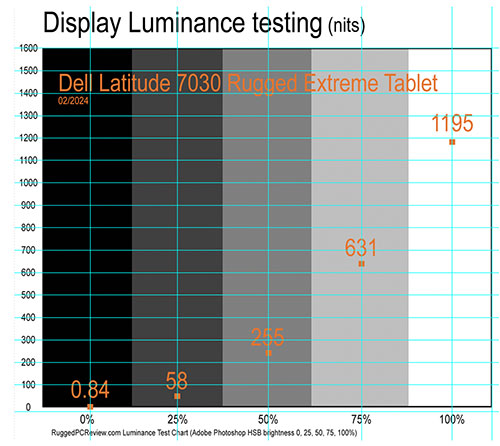 Outdoors is a) way brighter outdoors than indoors, and even the brightest display isn't a match for sunlight, and b) because outdoors there are always reflections that can quickly make a display unreadable.
Outdoors is a) way brighter outdoors than indoors, and even the brightest display isn't a match for sunlight, and b) because outdoors there are always reflections that can quickly make a display unreadable.
With regard to making LCD screens usable outdoors, Dell was a pioneer. As far back as 2007, Dell had laptop displays that had their screen cover optically bonded to the LCD, and display layers also bonded directly to each other, thus eliminating the number of reflecting surfaces, eliminating the need for multiple AR-coatings, and eliminating potentially troublesome air gaps between display layers.
The methods Dell applied reduced brightness-sapping reflectivity and resulted in a very good effective contrast ratio. Back in 2007, we termed it "definitely readable in sunlight." That was high praise in those days.
Time doesn't stand still though, and good outdoor-viewable displays are now available from all of the major rugged laptop vendors. Some are offering very high screen brightness of up to 1,500 nits, and optical treatments are continually refined. 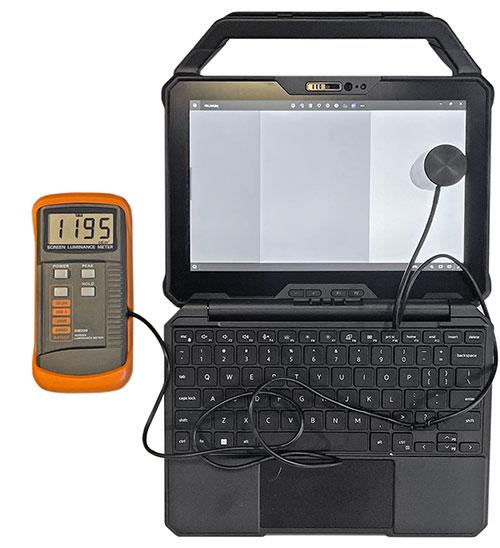 In the past, Dell favored advanced optical treatments that concentrated on reducing reflected light as opposed to using battery-draining super-bright backlights. That made for impressive outdoor viewability even without a strong backlight — a Dell rugged tablet we tested in 2017 had just 560 nits luminance and still provided good outdoor viewability.
In the past, Dell favored advanced optical treatments that concentrated on reducing reflected light as opposed to using battery-draining super-bright backlights. That made for impressive outdoor viewability even without a strong backlight — a Dell rugged tablet we tested in 2017 had just 560 nits luminance and still provided good outdoor viewability.
560 nits was respectable back then, but Dell went on to amp up brightness in more recent models. The Latitude 7220 tablet we tested in 2019 clocked in at a measured 1,020 nits. The current Latitude 7230, rated at 1200 nits, scored a very impressive 1337 in our testing, the highest we've seen in this class. And the new Latitude 7030 tablet, rated at 1,000, also turned out to be an overachiever, clocking in at 1,195 nits.
The picture series below shows the 7030 outdoors with, from left to right, first looking straight at the display, then angling it slightly so that the sky now reflects on the upper half of the display, and then angling it more so that the sky is reflecting on the full display.
Note the total absence of reflections on the left-most picture, and in the next two as well. That's a big plus of the 7030's semi-matte display compared to the glossy displays that used in almost all smartphones, consumer tablets and in most rugged tablets. Semi-matte displays mute reflections.

There is, however, always a tradeoff with current display technologies. Reflections don't just go away; they are an optical reality. The trick with semi-matte display is that they diffuse the light instead of harshly reflecting it back the way glossy display do. The flipside is that the muting also makes the screen look dimmer. Glossy display "pop" nicely for very vibrant pictures. But reflections are distracting and you constantly have to reposition glossy displays to avoid them. For many users, semi-matte is a better solution for outdoor work.
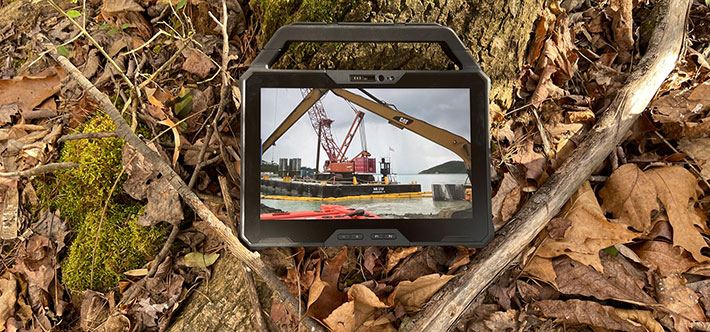
Exemplary tablet control interface
Tablets fail or succeed by not only the ease at which they can be used and controlled, but also by tablet-optimized software, apps and utilities. That's especially important in the Windows world which, despite progress made with Windows 10 and 11, is deeply rooted in decades' worth of the desktop/keyboard/mouse paradigm.
Dell knows that and that's the reason why their tablet has a number of physical control buttons to quickly adjust volume and screen brightness, and perform frequently used tasks with three programmable function keys. Thank you, Dell!
While the buttons help augment the tablet experience on the hardware side, Dell's also addressing matters on the software side. That's where the "Rugged Control Center" app comes in. It includes a dashboard that can be populated with one-touch hardware controls and quick launch shortcuts, and also allows setting of the programmable hardware buttons (each has a short press and a long press function). There are also tabs for GPS status, overall system information, and settings. Below are some sample screens (click on for enlarged version).

Also of note: the Dell Optimizer. It's like getting a checkup for your tablet, without having to resort to third party utilities that may or may not be legit. Support Assist makes sure you have the latest drives and downloads, scans the hardware for problems, cleans files, tunes performance, optimizes the network and nukes viruses and malware. It then logs a history so users have a record of how the system has been doing. SupportAssist also provides easy ways to contact an agent , submit files, and get online support.
Cameras: good enough for many jobs
The Latitude 7030 Rugged Extreme Tablet can be ordered with an optional integrated 5MP video front webcam with a hand-operated privacy shutter,  and also an 11MP (up from 8mp in the 7220) rear camera with LED flash that also has a manual privacy shutter. We used to question the need for such shutters, but no more. Privacy shutters are clever low-tech solutions to guard against the potential of unauthorized snooping via spyware or malware.
and also an 11MP (up from 8mp in the 7220) rear camera with LED flash that also has a manual privacy shutter. We used to question the need for such shutters, but no more. Privacy shutters are clever low-tech solutions to guard against the potential of unauthorized snooping via spyware or malware.
Virtually every smartphone and tablet has front and rear cameras these days, so excluding them in rugged tablets would probably be considered a negative by many customers. Cameras directly integrated into tablets can be used to document work, and, of course, having a camera with a 10-inch screen elevates picture-taking into an entirely new realm.
Below is a compilation of sample pictures taken with the 7030's rear camera. Tap on the image collection to bring up a full size version in a separate window.

We are not generally fans of the standard Windows Camera app. It's just too basic and generic to take full advantage of integrated cameras. The one in our review 7230 was rev 2023.2312.3.0. For image resolution there are just two settings, 3840 x 2160 for 16:9 format, and 3648 x 2736 for 4:3 aspect ratio. No problem with that; the 7030 has plenty of storage space even for a large number of high-res images.
 You can set a number of framing grids, you can set contrast, brightness, sharpness, saturation and privacy via the System camera settings, there's time lapse, and several flash settings. If you turn on "advanced controls" you get manual shutter and ISO control, exposure compensation, six white balance settings, timer, and digital zoom. There are several shooting modes: panorama, video, photo, document, whiteboard and barcode. The documentation camera also lets you get as close as four inches — good for sharp close-up details.
You can set a number of framing grids, you can set contrast, brightness, sharpness, saturation and privacy via the System camera settings, there's time lapse, and several flash settings. If you turn on "advanced controls" you get manual shutter and ISO control, exposure compensation, six white balance settings, timer, and digital zoom. There are several shooting modes: panorama, video, photo, document, whiteboard and barcode. The documentation camera also lets you get as close as four inches — good for sharp close-up details.
For video, there are six resolutions, starting with 480p and going up to 2160p (which is pretty much 4k video), all at 30 frames per second.
Bottomline here is that Dell gave the 7030 significantly better cameras than most rugged systems have. That's good because today's users are spoiled by the excellent cameras built into smartphones and also by the sophisticated camera imaging apps that are available. As is, this tablet's cameras are good enough for many documentation tasks, and certainly good enough for very good quality conferencing.
Tough and rugged
Ruggedness and durability are sore subjects with consumer tablets where almost universally style prevails over substance. Largely because of that, Dell points out that the 5-year total cost of ownership of a rugged solution is actually only half that of a consumer product.
 As is, there are lots of options in the rugged tablet space. When Dell initially announced their Latitude-based rugged Tablet several years ago, a product manager pointed out that fully-rugged tablets tend to be heavy and quite expensive, while lower priced tablets didn't have the kind of features and performance that many prospective tablet users need. So Dell aimed in between and has pursued that approach ever since.
As is, there are lots of options in the rugged tablet space. When Dell initially announced their Latitude-based rugged Tablet several years ago, a product manager pointed out that fully-rugged tablets tend to be heavy and quite expensive, while lower priced tablets didn't have the kind of features and performance that many prospective tablet users need. So Dell aimed in between and has pursued that approach ever since.
As a result, while the Latitude 7030 Rugged Extreme Tablet looks and feels solid and trust-inspiring, it is and feels light and definitely isn't a tank. Dell simply designed its rugged tablet to handle whatever hazards and conditions might be encountered in the real world.
Rugged tablets may be used in a wide range of temperatures, and so the Latitude 7030 Rugged Extreme Tablet can operate within an extremely wide temperature range of -20° to 145° Fahrenheit (-29° to 63°Centigrade), which means practically anywhere.
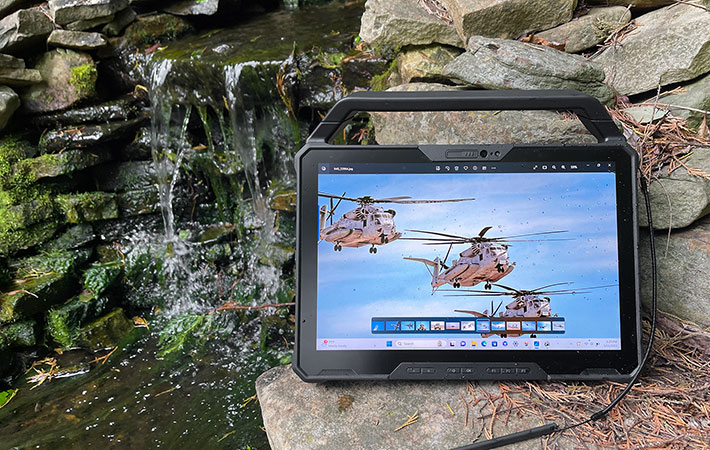
As for resistance to dust and liquids, the tablet carries an IP65 rating, where the "6" means the device is totally dust-proof, and the "5" that it can also handle low pressure water jets from all directions, albeit with "limited ingress permitted." Using the tablet in the rain is okay, spilling liquids on it is okay, but guard against submersion.
Drop tests were conducted in accordance with MIL-STD-810H. The 7030 passed the transit drop tests up to six feet, and 78 drops of single operating unit unit from three feet. That's impressive, but we like to see the ability to survive 4-foot drops while open and operating, because that is the height at which a laptop might be held while in a standing position.
Dell says the device is also independently tested according to MIL-STD-810G and the newer MIL-STD-810H procedures for transit drop, blowing rain, blowing dust and sand, vibration, functional shock, freeze/thaw cycles, and more.
Dell generally has ruggedness testing done by SGS United States and SGD Taiwan, SGS being one of the world's leading inspection, verification, testing and certification companies. Additional testing was done by the Taiwan and China locations of UL, a global independent safety science company. The images below were taken at a tour of Dell's own ruggedness testing facilities in Austin, Texas.
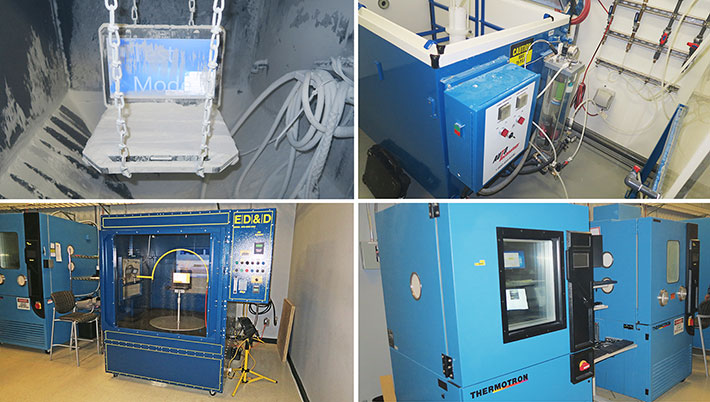
For use in hazardous locations, C1D2 certification is available. These are becoming more and more important, and they are a prerequisite for deployment in industries such as oil, gas, and petrochemical manufacturing, and many others where ignitable gases or vapor may be present.
Overall, the Latitude 7030 Rugged Extreme Tablet is just that, rugged. It's very well built, very sturdy, rubber bumpers provide good protection, and ports are well sealed with both plugs and sealing inside. That said, the emphasis here is on an intelligent balance of toughness and ease-of-use, not on heavy, vault-like invulnerability.
Summary: The Dell Latitude 7230 Rugged Extreme Tablet
Compared to Dell's overall sales volume (about $100 billion), the market for rugged tablets is fairly small, perhaps $700 million per year worldwide. Now having very competitive rugged tablet options not only in the 12-inch class, but with the new 7030 also in the 10-inch market will undoubtedly add to Dell's rugged sales.
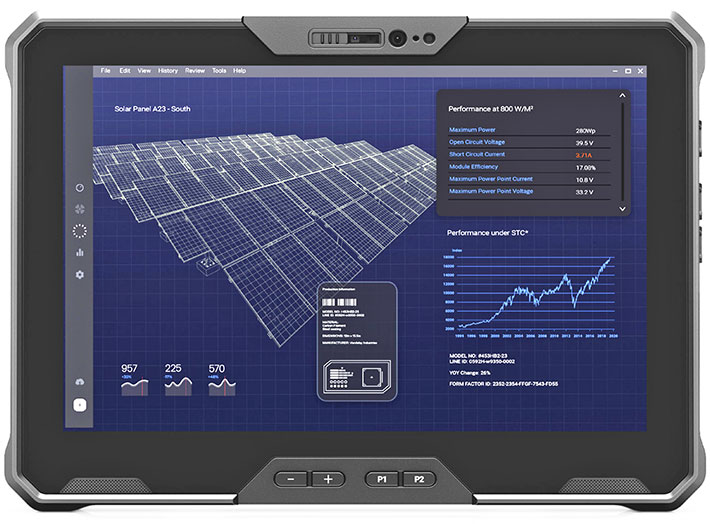
The new Latitude 7030 Rugged Extreme Tablet has a lot going for it. Its starting weight of just 2-1/4 pounds makes it a good deal lighter than the competition. In terms of tech and performance it is virtually identical to the powerful 12-inch 7230. It has excellent connectivity. It's nicely customizable, has a great detachable keyboard option, and also a roster of very useful accessories.
Its semi-matte 10.0-inch 1920 x 1200 pixel display is very bright and offers superior reflection control, making it easy to use outdoors and even in direct sunlight. It also provides effortless multi-touch capability that works even with gloves on. The included narrow-tip capacitive stylus works well, and there is also an active pen option. With a weight as low as two and a quarter pounds, the tablet is remarkably light and handy for a ruggedized device.
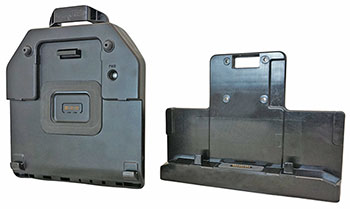 The Dell 7030 tablet covers connectivity basics (USB Type-A and dual Thunderbolt 4 or USB4/Type-C, Micro SD card) and can also be configured with fingerprint and standard or contactless smart card readers. For on-the-road use, there's a variety of Havis vehicle dock solutions with additional connectivity, for the office a handy desk dock with dual battery charging.
The Dell 7030 tablet covers connectivity basics (USB Type-A and dual Thunderbolt 4 or USB4/Type-C, Micro SD card) and can also be configured with fingerprint and standard or contactless smart card readers. For on-the-road use, there's a variety of Havis vehicle dock solutions with additional connectivity, for the office a handy desk dock with dual battery charging.
Available with a choice of three Intel 12th generation Core processors, the Dell Latitude 7030 Rugged Extreme Tablet combines very good performance with good power management, easily making full shift operation without battery recharging possible. Helping to achieve this high performance are very fast 5200MHz LPDDR5 RAM and PCIe NVMe solid state storage.
As the name implies, this is a rugged device designed to hold up to harsh conditions in the field. All ports have protective doors, there are fully integrated protective bumpers, the construction is very solid, and Dell provides comprehensive ruggedness testing data.
Add to that Dell's significant corporate capabilities and services and one-stop shopping appeal, and this new 10-inch rugged Windows tablet should very likely become quite popular. – Conrad H. Blickenstorfer, February 2024
|
Dell Latitude 7030 Rugged Extreme Tablet Specifications
|
| Added/changed |
Introduced 10/2023, full review 02/2024
|
| Type
|
Rugged tablet
|
| CPU
|
Intel 12th Gen Core i3-1210U, vPro, 6 cores/8 threads, up to 4.40GHz turbo
Intel 12th Gen Core i5-1240U, vPro, 10 cores/12 threads, up to 4.40GHz turbo
Intel 12th Gen Core i7-1260U, vPro, 10cores/12 threads, up to 4.70GHz turbo
|
| Thermal Design Power
|
All 9/29 watts
|
| OS
|
Windows 11 Pro
|
| Graphics
|
Core i3-1210U: Iris Xe with 96 graphics EUs
Core i5-1240U: Iris Xe with 80 graphics EUs
Core i7-1260U: Intel UHD Graphics
|
| Memory
|
Integrated 8GB, 16GB or 32GB 5200MHz LPDDR5 RAM
|
| Display
|
"Direct-View" outdoor-readable, anti-smudge, anti-glare, LED backlight, Corning Gorilla Glass 5 protective front glass, 1000 nits (1195 nits as tested)
|
| Display size and resolution
|
10.0-inch/1920 x 1200 pixel, 16:10 aspect ratio, 224 pixels per inch
|
| Digitizer/Pens
|
Capacitive multi-touch, water/glove-capable; optional active pen
|
| Keyboard
|
Onscreen, optional external
|
| Storage
|
M.2 socket PCIe/NVMe Cl 35 256 GB
M.2 socket PCIe/NVMe Cl 35 512 GB or
M.2 socket PCIe/NVMe Cl 35 1 TB or
M.2 socket PCIe/NVMe Cl 25 2 TB or
M.2 socket PCIe/NVMe Cl 35 256 GB or
M.2 socket PCIe/NVMe Cl 35 512 GB or
|
| Multimedia Pocket
|
None
|
| Slots
|
1 x Micro SD card, 1 x Micro SIM (dual battery configurations only); optional Smart card reader slot, NFC reader
|
| Housing
|
Plastic resin and thermoplastic elastomer (TPE), VESA 50 mounting points
|
| Temperature
|
-20° to 145°F (-29° to 63°C)
|
| Humidity
|
MIL-STD-810H, Method 507.5, Procedure II, 10-90% noncondensing
|
| Vehicle vibration
|
Est: ASTM D4169-04 (99), Schedule E, Truck Assurance Level II
|
| Salt Fog
|
MIL-STD-810H, Method 509.5, Procedure I (optional)
|
| Enclosure Class
|
IP65
|
| Altitude
|
MIL-STD-810H, Method 500.5, Procedure II (15,000 feet operating)
|
| Shock: Transit Drop
|
MIL-STD-810H transit drop (48")
|
| HazLoc
|
Optional: ANSI/ISA.12.12.01 certification capable (Class I, Division 2, Groups A, B, C, D)
|
| Certifications
|
See test report here (PDF).
|
| Size (inches)
|
10.33 x 7.40 x 1.00 inches (263 x 188 x 25 mm)
|
| Weight
|
Starting at 2.24 lbs. (1.016 kg)
|
| Power
|
Internal 36 Wh Li-Ion; optional dual 18 Whr Li-Ion replaceable, hot-swappable
|
| Cameras
|
Optional: User-facing 5mb RGB/VGA IR camera and 11mb documentation camera, both with mechanical privacy shutters
|
| Scanning
|
Optional: 1D/2D barcode scanner
|
| Security
|
TPM 2.0 FIPS-140-2 and TCG certified, fingerprint reader, chassis and battery intrusion detection, lock slot; optional: Fingerprint reader, Contacted Smart Card reader, NFC, and Control Vault 3
|
| Sensors
|
Hall sensor, gyroscope, eCompass/magnetometer, accelerometer, ambient light, proximity
|
| Communication
|
Intel Wi-Fi 6E AX211 802.11ax with MIMO + Bluetooth 5.2; opt. Qualcomm Wi-Fi 6E WCN6856-DBS, 802.11ax with MIMO + Bluetooth 5.3, 4G Qualcomm Snapdragon X12 Global LTE-Advanced (DW5825e), eSIM/SIM Dell Global 5G (DW5931E), eSIM/SIM
|
| GPS
|
GPS: uBlox NEO-M9N, L1 (1575.42 MHz)
|
| Interface
|
2 x Thunderbolt 4 with Power Delivery (Internal battery Option)
2 x USB 4 DisplayPort Type-C ports with Power Delivery (Hot Swap Battery Option)
1 x USB 3.2 Gen 1 Type-A with PowerShare
optional expansion I/O (top) barcode scanner OR USB 3.2 Gen 1 Type-A OR RJ45 Gbit Ethernet
|
| Price
|
As of end of February 2024, per Dell website the 7030 starts at $2,379
|
| Website
|
Dell Latitude 7030 Rugged Extreme Tablet
|
| Spec sheet
|
 Dell Latitude 7030 Rugged Extreme Tablet spec sheet Dell Latitude 7030 Rugged Extreme Tablet spec sheet
|
| Warranty
|
Standard 3-year mail-in service after remote diagnosis. Optional 3-5 year support, accidental damage, next-business-day
|






